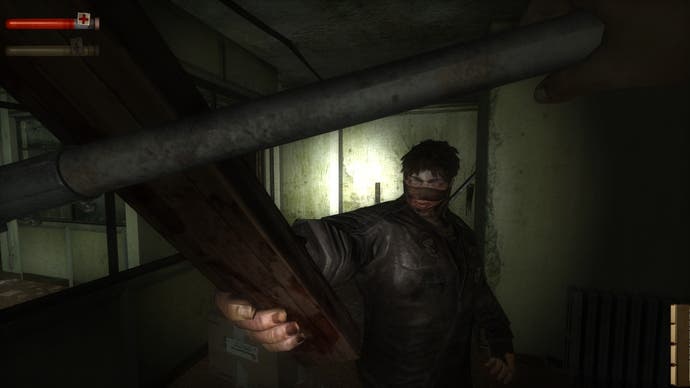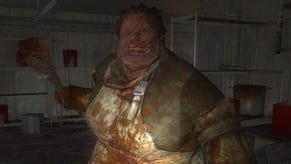Condemned: Criminal Origins retrospective
Beat it.
My favourite type of game is the first-person melee fighter, which is an unfortunate preference because the good ones are rarer than Fabergé eggs. Only a handful of games feature first-person brawling or swashbuckling at all, and in many of them like Skyrim, Dishonored and Dark Messiah it's only part of the overall experience, mixed together with magic and stealth. Games which rely on the mechanic almost entirely, such as Zeno Clash and Chivalry: Medieval Warfare, are scarcer still.
When you consider how difficult it is to make first-person melee combat feel good, this isn't particularly surprising. Not only do you have to deal with control systems that simply aren't designed to replicate the surprisingly intricate nature of one person swinging a heavy thing at another person swinging a heavy thing, the first person perspective also severely limits the player's field of view and ability to judge distance. If you want to replicate this experience in real life, get a stick and sit on the floor. Now clasp it between your feet, close one eye and try to swing.
That's generally what swinging a weapon feels like in games, clumsy, slow and flat. You'd have to be insane to try to base an entire game on such an awkward mechanic. So it's rather fitting that insanity is the overarching theme of Condemned: Criminal Origins, the first and perhaps only game to really get to grips with first-person melee combat.
In many ways it's oddly designed. In the beginning it briefly leads you on into thinking it's another standard shooter, even providing you with a pistol as your starting weapon. But there are little tells that suggest otherwise. Its lead character, FBI Agent Ethan Thomas, doesn't run by default like most FPS protagonists; instead he moves with plodding caution through the game's dilapidated environments as he investigates a string of serial murders. When asked to turn on your torch by your fellow investigator, there's no icon to suggest a rapidly depleting battery. You can abuse your torch-shining privileges as much as you like. Condemned wants you to see what's coming for you, and you're not going to be able to take it out from a distance.
Soon the pistol too is conveniently lost, and Ethan is forced to be more creative with his arsenal. Simplicity is the driving force behind Condemned's combat system. The weapons are basic, improvised from lead pipes and planks of wood, and the best weapon in the entire game is simply named the "Stick".
There are no flamboyant combos, no pre-animated special moves and no differentiation between light and heavy attacks. Your fighting abilities are limited to four directional swipes, a kick, and an overarm block that needs to be timed right in order to succeed. Oh, and a Taser that's stupidly overpowered and completely unbalances the game if you use it. Just pretend it isn't there.

Rather than trying to dazzle the player with flashy manoeuvres, Condemned focuses on making its opponents interesting to fight. The amount of work Monolith put into the animation and AI of Condemned's crazed thugs is still remarkable eight years on. You usually hear them first, panting, grunting and swearing under their breath as they approach. When they spot you they rarely attack directly. Instead they flit in and out of doorways and move toward you in a bizarre zigzag motion, trying to catch you off guard. Sometimes they'll run away and hide, leaping out at you from around a corner when you seek them out.
They're just as tricky when the fight begins. They feign attacks, fooling you into blocking early before striking out. If you do land a hit they retaliate immediately, using the force of your own attack to spin around and add additional momentum to theirs. If they lose their weapon, they'll run off and find another, or they might just leap at you, grab your arms and try to head-butt you into submission. They're vicious, unforgiving, and fantastic fun to fight.
Condemned understands that competitive fighting is fast and looks scrappy, as each combatant adjusts their own moves for what their opponent is doing. Keeping the control system simple, devoid of tricky moves that take time to perform, and making the opposing AI unpredictable enabled Monolith to capture that speed and fluidity. It's also why, although Condemned's combat system doesn't evolve much through the course of the game, it remains engaging, because no two fights ever pan out the same way. It constantly requires you to react to your opponent, rather than inputting a three-button combination to perform an unblockable spin-kick.
The combat system is certainly Condemned's strongest feature. But there's another side to Monolith's bludgeon-'em-up which, while less well implemented, is arguably more interesting. From time to time Ethan would put down his bloodied gas pipe and take out his camera to investigate crime scenes. I'm tempted to call them puzzles, but to be honest these sections were far too simplistic and prescribed for that, limited mostly to taking photos of evidence under various types of light and following trails of liquids through environments that were largely linear anyway.
Only in the ninth level, set in Apple Seed Orchard farmhouse, did the game actually throw you a proper conundrum to solve, which involved following mazy trails of insane writing through the house to piece together a riddle that gave you a clue to a secret room in the building.

Monolith criminally underplayed the investigative half of the game. But those crime-scene vignettes did provide an eight-level set-up for one of the best individual scares in gaming. Condemned's world and atmosphere is generally is not pleasant. Scenic locales for the virtual sightseer include an abandoned department store filled with men who pretend to be mannequins until you're within false arm's reach, and a burned out Library populated by equally burned-out humans who scuttle along the floor like insects and take swings at you through the bookshelves. But it's the inner-city high-school that tops the list of unappealing tourist attractions, and it's there that this moment takes place. It involves a gym locker, a corpse and a camera, and it's a cracker.
Condemned's horror was most effective when it stayed within the realms of reality, however twisted that reality may have been. The uncannily human AI made for a much more unsettling enemy than the supernatural horror of Monolith's other major title of the time, F.E.A.R., and Ethan's potential psychosis, the idea that you might be just as much a crazed thug as the people you were fighting, further added to this. Unfortunately, the game completely obliterates this more realist approach in the final level, when the story switches from chasing a serial killer of serial killers, which is only a moderately silly idea, to suddenly placing all the blame for the city's degradation on a cult who have a worrying obsession with piercings and make people go insane because of reasons.
For a game that takes itself very seriously indeed, it's a laughably dumb twist, akin to the film Se7en ending with the revelation that Kevin Spacey is a ghost. Worse, the sequel continued down this barmy route, ultimately giving Ethan a power that enabled him to sing at people until their heads exploded. Behind its gruff and thuggish exterior, Condemned ultimately lacked a little bit of confidence in the execution of its ideas. That's why it pretends to be a standard FPS at the beginning, why it throws that terrible Taser into a combat system that doesn't need it, why its forensic investigations are so restricted, and why at the final hurdle its plot makes an about turn and jumps the shark. It may even be why the combat system is so stripped down and straightforward, although I reckon such a suggestion does Monolith a disservice.
Either way, the result is the same. As a melee fighting game Condemned is yet to be beaten for both its originality and creating an authentic experience with the limited tools available, and until somebody finally cracks motion-controlled sword-fighting, it will likely remain that way.










